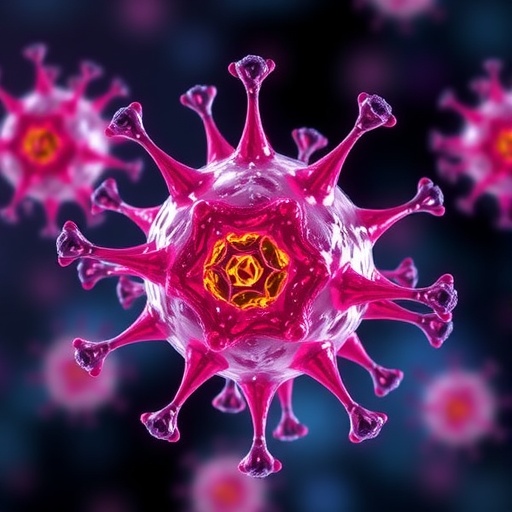Cells are equipped with a remarkable self-cleaning mechanism akin to taking out the trash in a household—a vital process known as autophagy. This biological system ensures unwanted or damaged cellular components are encapsulated within a double-membrane sac called the phagophore, which then matures into an autophagosome. Once enclosed, these cellular “waste” packets are transported to lysosomes, the cell’s incinerators, where they are broken down and recycled. This continuous clearance prevents cellular damage accumulation, which, if unchecked, can lead to cell death and contribute to numerous diseases.
A breakthrough study conducted by researchers at Aarhus University’s Department of Biomedicine, led by Professor Fulvio Reggiori, has shed light on a critical regulatory mechanism controlling the expansion of this autophagic sack. This discovery centers on a molecular “switch” named Ypt1, also known as RAB1, which orchestrates the enlargement of the phagophore to accommodate varying quantities of cellular debris. Understanding the precise molecular cues that govern this switch opens up exciting avenues for manipulating autophagy therapeutically.
Before this research, the initial formation of the phagophore was relatively well-understood; however, the mechanisms enabling its enlargement remained obscure. The Aarhus team has identified that Ypt1 functions as a gatekeeper, coordinating both the supply of lipid building blocks and the autophagic machinery necessary for phagophore growth. This regulation is essential because the phagophore must adjust its size dynamically depending on the volume of intracellular material targeted for degradation, making Ypt1 a crucial node in cellular homeostasis.
The process begins with the phagophore establishing a physical bridge with the endoplasmic reticulum exit sites (ERES), which are major lipid production factories within the cell. This membrane contact site acts as a conduit through which lipids are delivered to the expanding phagophore membrane. Ypt1 activates this lipid transfer by signaling the formation of this bridge, effectively pressing the “gas pedal” for autophagic expansion. This coordinated response ensures that the autophagic membrane has sufficient resources to encapsulate its cargo fully.
Such a molecular switch not only enhances our fundamental understanding of autophagy but also holds profound implications for human health. In neurodegenerative diseases like dementia and amyotrophic lateral sclerosis (ALS), defective autophagy leads to the accumulation of toxic protein aggregates. By pharmacologically “stepping on the gas,” it might one day be possible to stimulate autophagy and clear these harmful deposits, slowing disease progression. Conversely, many cancer cells exploit autophagy for survival under stressful conditions, suggesting that “hitting the brakes” on Ypt1 activity could starve tumors by disrupting their cellular housekeeping.
The double-edged role of autophagy in health and disease underscores the importance of precise regulation rather than wholesale activation or inhibition. This delicate balance implies that therapeutic modulation must be finely tuned, tailored to the pathological context. The identification of Ypt1’s role in phagophore expansion offers a novel target to develop such therapies, enabling selective augmentation or suppression of autophagic flux as needed.
Professor Reggiori explains that the research utilized advanced biochemical and imaging techniques to decipher these molecular interactions. By mapping the interface between the phagophore and the endoplasmic reticulum, and demonstrating the necessity of Ypt1 for their contact site formation, the study clarifies how cells translate biochemical signals into physical membrane remodeling. This mechanistic insight represents a significant leap forward in the field of cell biology and autophagy research.
Beyond neurodegeneration and cancer, autophagy plays an essential role in immunity and infection control. By modulating autophagic flux, immune cells can enhance the clearance of intracellular pathogens, presenting another therapeutic frontier. Understanding Ypt1’s regulatory function could thus inform drug development aiming to boost host defenses against a range of infectious agents.
While the discovery marks a crucial milestone, the researchers emphasize that more work is needed to translate these findings into clinical applications. The complexity of the autophagy pathway, with its myriad interacting proteins and dynamic membrane behaviors, demands comprehensive study. Future investigations will explore the regulatory networks upstream and downstream of Ypt1, druggable targets within this signaling axis, and potential side effects of modulating this pathway in vivo.
The study also highlights the value of collaborative research, with contributions from experts at Osnabrueck University, Germany, and Cornell University, USA. Supported by funding from the Novo Nordisk Foundation and the Dutch Research Council, this work exemplifies international cooperation in addressing fundamental yet clinically relevant biological questions.
In essence, the identification of Ypt1 as a molecular switch responsible for phagophore expansion provides a crucial missing link in our understanding of autophagy. This foundational knowledge not only enriches basic cell biology but also charts a promising roadmap toward innovative treatments for diseases characterized by cellular waste accumulation or autophagy-dependent survival.
As the field advances, it is conceivable that pharmacological agents targeting the Ypt1 pathway will become part of personalized therapeutic regimens. Such future treatments may revolutionize how conditions like cancer, neurodegeneration, and infections are managed, turning cellular trash management from a mundane housekeeping process into a powerful ally in medicine.
Subject of Research: Molecular regulation of autophagy via the Ypt1/RAB1 switch controlling phagophore expansion
Article Title: Establishment of the phagophore–ERES membrane contact site initiates phagophore elongation
Image Credits: Jens Hartmann Schmidt, Aarhus University
Keywords: Autophagy, phagophore expansion, Ypt1, RAB1, lysosome, membrane contact site, endoplasmic reticulum exit site, neurodegeneration, cancer, intracellular degradation




